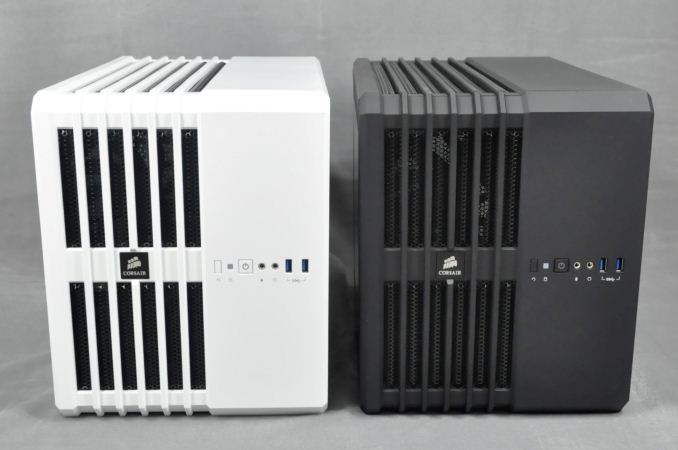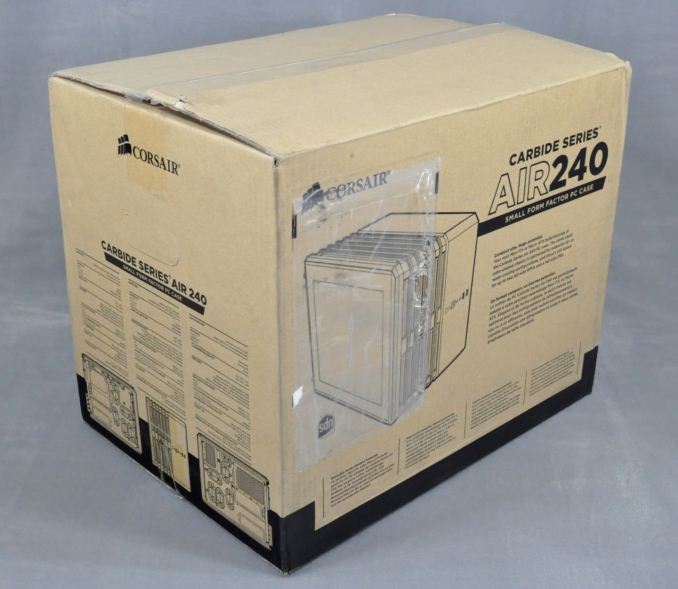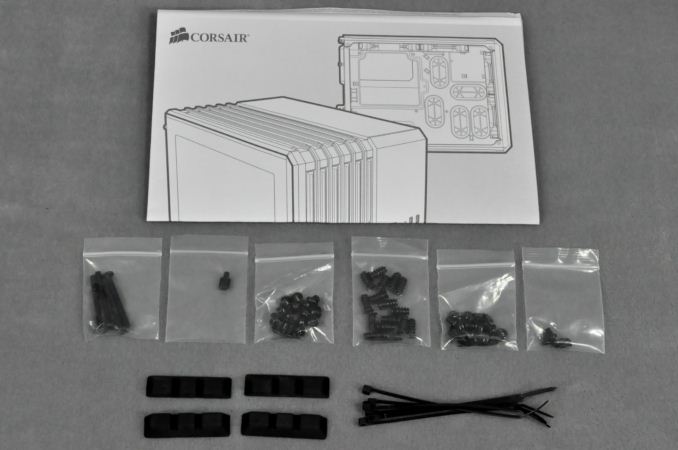Corsair Carbide Air 240 Case Review
by E. Fylladitakis on August 15, 2014 6:00 AM EST- Posted in
- Cases/Cooling/PSUs
- Corsair
- ATX
- Case
- Carbide

Introduction
Corsair is a company originally known for their quality RAM modules, but they have expanded into many other areas of the PC market. Today, Corsair is one of the most important players in the computer hardware market, with the company offering dozens of products, designed to cater to as wide an array of people as possible. Looking just at their computer cases, Corsair offers five series with an ever-expanding number of products, ranging from super-large cases for enthusiasts to low-cost products for budget-driven users. In this review, we will look at one of their latest case designs, the Carbide Air 240.
Compact cases and small form factors are all the rage nowadays. Some companies, such as Silverstone, have focused many of their R&D resources on the development of such designs. The first compact case that we reviewed from Corsair was the Obsidian 250D, a cubic Mini-ITX case of not so compact proportions; instead, it was designed to fit fairly powerful combinations of hardware. This is also true of the Carbide Air 240 that we will be reviewing today. Although it is designed to fit up to Micro-ATX motherboards, the Carbide Air 240 can accommodate very powerful hardware, including two top-tier GPUs and dual liquid cooling radiators. We will look at its design, features, strengths, and weaknesses in this review.
| Corsair Carbide Air 240 Specifications | ||
| Motherboard Form Factor | Mini-ITX, Micro-ATX | |
| Drive Bays | External | - |
| Internal |
3 x 2.5" or 3.5" (rear cage) 3 x 2.5" (top cage) |
|
| Cooling | Front | 2 x 120 (2 x 120mm included) |
| Rear | 2 x 80mm (optional) | |
| Top | 2 x 120mm (one included) | |
| Right Side | 1 x 120mm (optional) | |
| Bottom | 2 x 120 (optional) | |
| I/O Port |
2 × USB 3.0 2 × USB 3.0 1 × Headphone 1 × Mic |
|
| Power Supply Size | ATX | |
| Clearances | HSF | 125mm |
| PSU | 200mm | |
| GPU | 360 mm | |
| Dimensions |
~315mm × 265mm × 400mm (H×W×D) ~12.4in × 10.43in × 15.75in (H×W×D) |
|
| Pricing | ~$90 online | |
Packaging and bundle
The Corsair Carbide Air 240 comes supplied in a simple, brown cardboard box. The artwork on the box is limited to schematics of the case and text. Inside the box, the lightweight case is protected by thick polystyrene foam slabs and is wrapped in a nylon bag.
Corsair kept the items bundled with the Carbide Air 240 down to a minimum but organized them well, supplying each type of screw inside a separate nylon bag. There are also four rubber feet for the case and a few short cable ties.












63 Comments
View All Comments
MichaelD - Friday, August 15, 2014 - link
I've been looking for a small-ish case to build my new gaming PC in and this was looking so promising, until I saw that it has no 5.25" bay. For a daily-use PC at least one optical drive bay is mandatory. Some of us actually still buy our games on physical DVDs and it's nice to be able to burn a DVD or CD when you need to.kmmatney - Friday, August 15, 2014 - link
Between my wife and 3 kids, and work, I have 10 computers in the house, and most of them share an external USB drive - and the need for that is rare. it would be nice if this supported a slim optical drive, though - those take little room.brbubba - Friday, August 15, 2014 - link
I thought the same thing about my Air 540 because my water reservoir takes up the two 5.25" bays, but now that my DVDRom/CDRom is gone I haven't missed it. If you are still living in the 90's and haven't made the switch to Steam then just rip ISOs of all your games.romrunning - Friday, August 15, 2014 - link
Take a look at Silverstone's SUGO series - specificially the mini-ITX SG05 model. It can take a very decently sized GPU, and you can buy the case with a 450W PSU. It has a 5.25" slot for a slimline SATA disc drive; buy the slimline SATA power adapter cable 'cause they don't include it. The Silverstone case is also significantly smaller than this case. Great gaming case for a single GPU!I bought it, and I love it. I use the disc drive for when I buy CDs on sale; it's cheaper to get whole CD of 11-14 tracks when on sale than it is to buy individual tracks as MP3 downloads. I can then rip the whole disc & add it to my music library.
Grok42 - Saturday, August 16, 2014 - link
Mandatory? I'm not sure that word means what you think it does. Do some people still buy physical media? Sure, but I can't understand why. Every game is available online and it doesn't require you juggle disks when changing games. If you don't have good Internet I could understand but then just use an external drive. Rip them as ISO files so you don't need it connected all the time. It really isn't that difficult. You can upgrade more important parts of your system with the $20 you save.hapkiman - Friday, August 15, 2014 - link
I really like my Air 540, in fact its been the best case I've ever had. This one looks like its just going to be too cramped in there for good airflow. Plus its too wide to fit under an entertainment center.I'm not sold on this one.
brbubba - Friday, August 15, 2014 - link
"We cannot really claim that it is a unique case, both because many cubic cases are available"ORLY?
SirGCal - Friday, August 15, 2014 - link
I don't understand the non-need for an optical drive. I use mine for system images, backups, etc. I constantly use it nearly every day. Not to mention just to watch a movie while I'm working... Even on my laptop, I use the optical drive with some regularity. External drives never have interested me but with a case this huge, why isn't there one slot somewhere, even on the side? I just don't get it. I also have micro-ITX builds, smaller then this, but they still have an optical drive.SirGCal - Friday, August 15, 2014 - link
err Micro-ATX and Mini-ITX. I actually have both right now. Not a fan of the ITX honestly. One PCIe seems to be a problem when I want to use a PCIe SSD setup along with a deticated GPU. But that's another topic. Still, micro builds, for many of us, still need optical drives just for daily usage.ZeDestructor - Saturday, August 16, 2014 - link
For most people, backups, system images and all manner of not commonly accessed data (like movies, game installer and the like) goes on external drives or NAS boxes, if only for the convenience.Meanwhile, a 100pc DVD-R spindle costs $23.68, which works out to $94.72 for ~2TB. A single 2TB 7200rpm HDD costs $93. In addition, the HDD is faster, rewritable and takes significantly less space, and much more convenient since you don't have to swap disks as often.
Just yesterday I was helping a friend wrap up his NAS4Free install with ZFS (inside ESXi, fuck you VMware for removing RDMs from the vclient ui!), something he's doing to get a nice, always on, accessible anywhere library of media, mostly so that he can brick his PC(s) while watching movies on his projector.